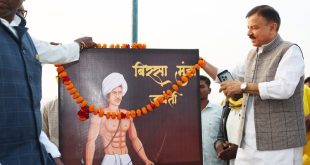
New Delhi: In its 42-year journey of strengthening democracy, EVMs (Electronic Voting Machines) have been accused of countless irregularities. It was first used in 1982. Since then, a long battle was fought from the High Court to the Supreme Court, but EVM has stood the test of time. Anyway, the Election Commission has strict rules regarding EVMs used in elections. From assembling to voting, EVMs have to go through about five hundred trials and half a dozen mock polls. It has been used at every level. The special thing is that all the trials and mock polls take place in the presence of political parties, whereas most of the leaders change their tune after the election results are declared. To maintain credibility among the supporters, the instrument of defeat has been set on EVMs.
In such a situation, many other important steps have been taken to strengthen people's confidence in EVMs. There is also a move to link EVMs with VVPAT (Voter Verified Paper Audit Poll). Through this, every voter can see whether the person for whom he has voted has got his vote or not. Despite this, EVMs are kept in the dock. This is the situation when the Election Commission has included political parties in every process from EVM operation to its maintenance and testing. They are immediately given information about EVM related activities. Not only this, the Commission has challenged all the political parties on the allegations of tampering. It has also been clarified that it cannot be connected through Bluetooth, Internet or any other means because it is a single machine. Apart from this, each EVM has a programming chip, which can be used only once.
Over 480 criteria have been met
As per the standard protocol of the Election Commission, each EVM is tested on more than 480 parameters after it is ready. The Control Unit (CU) has been tested 403 times, the Ballot Unit (BU) 45 times and the VVPAT 32 times. If even one criterion is lacking then it is immediately rejected. EVMs are controlled by Bharat Electronics Limited, an entity affiliated with the Defense Ministry. Currently its plants are in Bengaluru, Hyderabad and Panchkula. Before being used in any election, EVMs have to go through mock polls about half a dozen times. There is partnership of political parties in all these. The results were announced in front of everyone. These also include merger of VVPAT.
EVMs are sometimes tested before elections.
EVMs and VVPATs are tested about six times before being used in elections. It starts during assembling but each machine is properly checked before it is taken out of the warehouse for election use. A list of defective machines is also prepared, which is shared with political parties. The second round of testing is done by loading dummy symbols. Meanwhile the button with the name of each dummy candidate is pressed six times. Later the votes and VVPAT slips are tallied. On successful completion they are placed for the next round of examination. Of these, five percent of the already passed EVMs are checked from time to time, leaving 1200 votes in one percent of the EVMs, 1000 in two percent and 500 votes in the remaining two percent. Later it is mixed in VVPAT. If found correct then the next round of investigation is conducted. This is broadly called mock poll. After the names are finalized in the elections, the fourth check is done after the names of the candidates are uploaded in the EVM. The button with the name of the candidate along with the note is pressed one by one. After the fifth check single is uploaded, five percent of the EVMs ready for election are removed from time to time and a total of one thousand votes are cast. These are mixed with the VVPAT slips, during which candidates or their representatives are told that they can also have the EVMs checked at any time. The sixth investigation is that this is the process before the voting starts at the booth. A candidate or his agent is given the opportunity to cast a vote. Then their faces get mixed up. If found correct, those votes are publicly removed from the EVM. All six investigations involve representatives of political parties.
Till now 148 assembly and four general elections have been held using EVMs.
So far, 148 assembly elections and four Lok Sabha elections have been held in the country through EVMs. Preparations are also underway to conduct the 2024 Lok Sabha elections using EVMs. The Congress-led UPA has taken power at the Center twice out of the four Lok Sabha elections. In 2014 and 2019, the BJP-led NDA won the maximum number of seats and formed the government. In Chhattisgarh, elections have been held using EVMs maximum six times in 2000, 2003, 2008, 2013, 2018 and 2023.
Slips of 20 thousand booths were mixed, no problem
The reliability of EVMs can be judged from the fact that for the first time in the 2019 Lok Sabha elections, VVPAT was used along with EVMs in 10.37 lakh booths of all 543 Lok Sabha seats. In this, under the instructions of the Supreme Court, the slips of five booths of each assembly were to be mixed randomly. In such a situation, VVPAT slips were matched with the votes cast at 20,600 booths across the country, which were found to be completely correct, not a single vote was mismatched.
EVM's journey started in 1982
EVMs were first used in elections in 1982 in Ernakulam district of Kerala. Trial experiment was conducted at 50 booths. Initially only eight candidates could participate in EVM, but now 17 candidates can participate. This also includes notes. With the help of EVM, in the current phase, 384 candidates can be elected simultaneously from one seat. VVPAT was first used in 2013 elections in Nagaland.
 look news india
look news india
